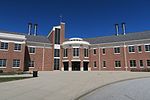Sterling, Connecticut
Sterling, ConnecticutTowns in ConnecticutTowns in Northeastern Connecticut Planning Region, ConnecticutTowns in Windham County, ConnecticutUse mdy dates from July 2023

Sterling is a town in Windham County, Connecticut, United States. The town is part of the Northeastern Connecticut Planning Region. The population was 3,578 at the 2020 census. The rural town is home to two villages: Oneco (named for Oneco, Sachem of the Mohegans) and Sterling village. Each contains a post office, a church, and a fire station. The town hall and public library are located in Oneco, and the town's one public school is in Sterling village.
Excerpt from the Wikipedia article Sterling, Connecticut (License: CC BY-SA 3.0, Authors, Images).Sterling, Connecticut
Sterling Road,
Geographical coordinates (GPS) Address Nearby Places Show on map
Geographical coordinates (GPS)
| Latitude | Longitude |
|---|---|
| N 41.702222222222 ° | E -71.816388888889 ° |
Address
Sterling Road 654
06377
Connecticut, United States
Open on Google Maps










